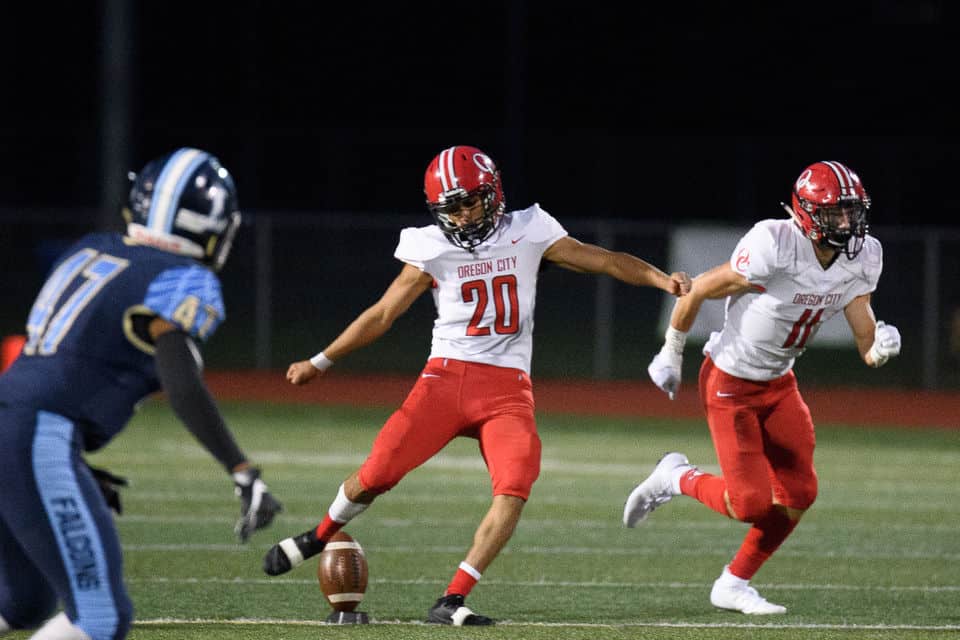Become the “Unsung Hero” of high school football
Not every high school coach is keen to attempt field goals — as a matter of fact, it’s just the reverse — few high school coaches attempt more than a handful of kicks every season. Even when they have a real weapon on the sidelines.
Why?
Most coaches weren’t kickers, for starters, and they don’t know how to teach the mechanics of kicking. And, they may not have much confidence in the holder, snapper or even the line. It’s just easier to “go for it”.
One thing is for certain, every team will kick off — and hope to many times each game. Even then, coaches may only ask their kickers to hit squibbs in the hopes of avoiding kicking a line drive to a speedy returner or frankly, not having much faith in his kick off coverage team.
That’s a lot to have on your plate. No wonder even good kickers are sent to do only half of what they are capable of. But the antedote to a boring high school kicking career is to be the guy who can consistently put the ball into the end zone on kick offs… the “Unsung Hero” of high school football.
Why?
Because unlike college or the pros, a ball that reaches the goal line is automatically dead — a touchback — and placed at the 20 yard line. No speedy return man. No “taking it to the house”. No injuries. No sweat.
Most high school kickoff returns will reach well past the 35 yard line. A team with a kicker capable of reaching the end zone will likely be First Team All-Conference because it gives their team a crucial field position advantage…. at least 15 yards. No team wants to start their offense on the 20. 80 yards is a long way to go to get points.
Four things to help you reach the goal line:
1) Consistent Steps
How many times do you see an NFL kicker stutter step to the tee? Never. But you often see it in high school. That’s because the kicker doesn’t really know where to line up to take a 5 to 10 yard run up to the ball and make an effective strike on the ball. A simple drill to fix this is to work “backwards”.
Stand where your plant is next to the ball and tee. Then take your “WALK, RUN, ATTACK” steps on your line to the ball, BACK to where you normally start. Have a friend spot your plant foot. Do it a few times to see if it’s reasonably consistent. That’s where you start from . Mark that spot and take your steps from the ball to that mark. Your body is still growing. This drill is good anytime you start to feel less confident about your approach.
The NFL kicker is only thinking about getting a great strike on the ball. He is not thinking about misstepping on the way to the ball. This will give you greater confidence to really take a big swing that won’t end in a spinner or knuckleball.
2) “Be the Ball”
If you remember Caddyshack, Chevy Chase’s character tells this advice to his protege when putting. It’s supposed to be a Zen-thing. That’s not exactly what I’m talking about here. Being the ball is giving yourself all greater confidence that even if you mishit the ball, bad things are unlikely to happen. Knowing that, you’re chances of striking better are improved.
How?
Before the game, check out the field on both sides to know where the best places to put your tee are. No divots or bald spots, please. If you are to kick away from a particular player, do you know who and where he linees up? Perhaps you should kick from a hash? Hitting the ball to 1/3 of the field improves your teams chances of covering it. Or are you just kicking off from the middle and seeing what happens? That’s a recipe for scores going back the other way.
Do you see the line for your ball… to infinity? Don’t kick it to a guy, kick it passed the guy. To borrow from another movie, “There is no spoon.” As in, “there is no return man”. When your kick sails into the end zone, it’s as if there wasn’t anyone to catch it. We have a tendency to kick the ball to people — instead of as far as we can go on a straight line.
3) Use a higher tee
This may revolutionize your game. In the NFL and NCAA, you can only use a 1-inch tee. So a decade ago, everyone started using a “Zero-tee”. The big black tee that sets the ball up very nicely. However, everyone… and I mean everyone buys the 1-inch tee. (There is a 2-inch version). Back in the day, we used the old orange Boomer tee or the red Stenerud tee. They were 2-inch tees… you can still buy them.
A 2-inch tee is legal in high school.
Why wouldn’t you use a tool that help get the ball higher and farther down the field? Because you’re going to NOT impress college scouts who aren’t even at your game? What? No one will notice, except for your coach and the other team when you balls sail into the end zone. That’s what’s impressive. You’ll have plenty of time to switch to a 1-inch tee if you’re heading on to college ball.
4) Get stronger with more mobility
Strength training for kickers has often been an after-thought. If your’re serious about kicking, you need to get into the weight room and work a full body workout, with special emphasis on your legs and explosive power — along with the ability to decelerate with your core.
What does all that mean?
Watch this video and you’ll begin to understand. There are plenty of great mobility (stretching) kinds of exercises that require no weights. There’s no excuse not to put your body in your best physical shape.
Do so, and you’ll find that you’ve improved your team’s chance of winning games by a ton — while earning your coach’s respect and trust… maybe even enough to attempt a field goal or two!
In case this video doesn’t link, here’s the URL > https://www.youtube.com/watch?v=dCcJVdIC43A&t=385s
This is an excellent video from a strength training coach who doesn’t have a kicker physique, but his advice will have you kicking 5-10 yards further. Pay attention to the types of drills — and the reasons for those drills to enhance distance on your kicks and punts.

